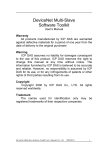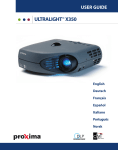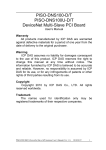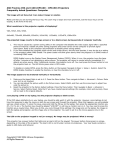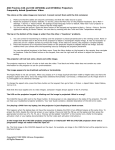Download Proxima DP5100 User`s guide
Transcript
USER’S GUIDE Model DP5100 Warranty Proxima Corporation warrants that the Proxima® Desktop Projector™ product manufactured by Proxima is free from defects in materials and workmanship under normal use during the Warranty Period. The Warranty Period commences on the day of purchase by the end–user. The Warranty Period is one year. The Desktop Projector lamps are not covered by this Warranty. The end–user’s sales receipt or invoice showing the date of purchase of the product and the name of the Reseller is proof of date of purchase. The Warranty extends only to the original purchaser and is not transferable. During the Warranty Period, Proxima will, at no additional charge, repair or replace defective parts or at the option of Proxima, replace the entire unit. This limited Warranty does not extend to any Proxima product that has been damaged or been rendered defective (a) as a result of accident, misuse or other abuse; (b) by the use of parts not manufactured or sold by Proxima; (c) by modification of the product; or (d) as a result of servicing by non–authorized personnel. Limitation of Warranties The foregoing Warranty is expressly in lieu of any other expressed or implied warranties, including, without limitation, warranties of merchantability or fitness for a particular purpose. To the extent not prohibited by law, all statutory warranties are hereby waived and excluded from this Warranty. Proxima expressly disclaims all warranties not stated in this Limited Warranty. FCC Statement Warning: This equipment generates, uses and can radiate radio frequency energy and, if not installed and used in accordance with the instruction manual, may cause interference to radio communications. It has been tested and found to comply with limits for a Class “A” computing device pursuant to Subpart B of Part 15 of the FCC Rules, which are designed to provide reasonable protection against such interference when operated in a commercial environment. Operation of this equipment in a residential area is likely to cause interference in which case the user, at his own expense, will be required to take whatever measures may be necessary to correct the interference. Trademarks, Patents, and Copyright Proxima is a registered trademark of Proxima Corporation. Desktop Projector and trade dress are trademarks of Proxima Corporation. IBM is a registered trademark of International Business Machines Corporation. Macintosh is a registered trademark of Apple Computer, Inc. Other trademarks are the property of their respective owners. U.S. and foreign patents are pending. © Copyright 1995 Proxima Corporation. All rights reserved. Specifications are subject to change without notice. 7/95 Contents Introduction .................................................................... 1–1 Introducing the What’s in the Box? ........................................................... 1–2 Proxima ® Quick Setup Desktop Computers .................................... 1–3 Desktop Quick Setup Laptop and Notebooks ............................... 1–4 Chapter 1 Projector™ Your Proxima Desktop Projector ..................................... 2–1 Setting up the Projector ................................................... 2–2 Detailed Setup Connecting the Desktop Projector .................................. 2–3 COMPUTER (RGB) ............................................... 2–4 VIDEO IN............................................................... 2–6 S–VHS ..................................................................... 2–7 COMPUTER AUDIO IN....................................... 2–7 AUDIO IN .............................................................. 2–8 AUDIO System ........................................................ 2–9 Powering Up ................................................................... 2–9 Applying Power to the Projector .............................. 2–9 Turning On/Off the Lamp..................................... 2–10 Projecting the Image ...................................................... 2–11 Image Size .............................................................. 2–11 Image Sizing and Focusing ..................................... 2–12 Keystoning ............................................................. 2–12 Chapter 2 Chapter 3 Using the Desktop Projector The Control Panel ........................................................... 3–1 Control Panel Keys .......................................................... 3–2 STANDBY/ON Key ................................................ 3–2 INPUT Key ............................................................. 3–2 ZOOM Key ............................................................. 3–2 FOCUS Key............................................................. 3–2 Control Panel Indicators .................................................. 3–3 TEMP Indicator....................................................... 3–3 LAMP Indicator ....................................................... 3–4 ON Indicator ........................................................... 3–4 Remote Control ............................................................... 3–5 STANDBY/ON Key ................................................ 3–6 RESET Key .............................................................. 3–6 CALL Key ................................................................ 3–6 INPUT SELECT Keys ............................................. 3–6 ZOOM Key ............................................................. 3–7 FOCUS Key............................................................. 3–7 MENU Keys ............................................................ 3–7 VOLUME Keys ....................................................... 3–8 MUTE Key .............................................................. 3–8 CHANGE Keys ....................................................... 3–8 BLUE BACK Key .................................................... 3–8 LIGHT Key (on side of remote control) .................. 3–8 Menus ............................................................................. 3–9 Displaying the Menu ................................................ 3–9 Selecting and Changing Settins ................................ 3–9 Saving Changes ........................................................ 3–9 Computer (RGB) Video Menu .............................. 3–10 Video Menu ........................................................... 3–11 Chapter 4 Maintenance Chapter 5 Troubleshooting Lens Cleaning .................................................................. 4–1 General Maintenance....................................................... 4–2 Replacing the Lamp ................................................. 4–2 Cleaning the Air Filter.............................................. 4–3 Changing the Remote Control’s Batteries ................ 4–5 Temperature Extremes ............................................. 4–5 Troubleshooting Chart .................................................... 5–1 Where to Get Help .......................................................... 5–4 Appendix A Specifications Appendix B Accessories & Replacement Parts Index Chapter 1 • Introducing the Proxima ® Desktop Projector Chapter 1 Introducing the Proxima Desktop Projector The Proxima® Desktop Projector™ Model DP5100 is a portable, color data and video LCD desktop projection product that makes sharing data and presenting information as easy as connecting your computer to your monitor. 800 600 400 200 0 800 APR M AY JUN 600 400 200 0 APR MAY JUN JUL JUL TEMP LAMP ON STANDBY /ON INPUT T W ZOOM N FOCUS F Figure 1-1 The Proxima Desktop Projector DP5100 in use User’s Guide • 1–1 Chapter 1 • Introducing the Proxima® Desktop Projector What’s in the Box? After you’ve opened the box and removed the Desktop Projector, make sure you have all the items shown in Figure 1-2. CAUTION! The Desktop Projector 5100 should be treated like any other precision optical instrument. Handle it carefully. STAND /ON BY RESET INPUT VIDEO 1/2 VIDEO CALL RGB 1/2 RGB T ZOOM H F FOCUS W N MENU VOL MENU VOL MENU MUTE CHANG E V BLUE BACK Proxima Desktop Projector Remote control Power cord Composite audio/video cable VGA video cable Macintosh video cable adaptor Also included but not shown: • (2) AA alkaline batteries • User's Guide • Product Registration Card Figure 1-2 Items included with the Desktop Projector 5100 1–2 • User’s Guide Chapter 1 • Introducing the Proxima ® Desktop Projector Quick Setup: Desktop Computers Here are the steps you follow to connect your PC or Macintosh to the projector (to connect to a laptop or notebook computer, follow the instructions on the next page). Each step is described in detail in Chapter 2. 1. Place the projector on a solid, flat surface, at a right angle (perpendicular) to the projection screen, parallel to the floor. 2. Remove the lens cover. 3. Turn off the computer, the monitor, and the projector. 4. Unplug the monitor cable from the video monitor port on your computer. 5. If you are using a Macintosh, a) Connect the Macintosh video cable adaptor (supplied with the projector) to either end of the DP5100 VGA video cable. Macintosh Video Cable Adaptor VGA video cable b) Plug the other end of the Macintosh video cable adaptor into the Macintosh’s video output (monitor) port. Skip ahead to step 7. 6. To connect to a PC, plug one end of the DP5100 VGA video cable into the computer’s video output (monitor) port. 7. Plug the other end of the DP5100 VGA video cable into the projector’s COMPUTER (RGB) 1 or 2 port. 1 2 RGB 8. To connect additional video and audio sources to the projector, see pages 2-6 through 2-9. 9. Turn on the projector, then turn on your computer and monitor. User’s Guide • 1–3 Chapter 1 • Introducing the Proxima® Desktop Projector Quick Setup: To connect the projector to your laptop or notebook computer, Laptop and follow these instructions. Each step is described in detail in Notebooks Chapter 2. 1. Place the projector on a solid, flat surface, at a right angle (perpendicular) to the projection screen, parallel to the floor. 2. Remove the lens cover. 3. Turn off the computer and the projector. 4. If you have a PC laptop, skip ahead to step 5. To connect to a Macintosh laptop, you will use two additional cables: a) Plug the laptop video adaptor cable (supplied with the laptop) into the laptop. Macintosh Video Cable Adaptor b) Connect one end of the Macintosh video cable adaptor (supplied with the projector) to the laptop video adaptor cable. c) Connect the other end of the Macintosh video cable adapter to either end of the DP5100 VGA video cable. Skip ahead to step 6. VGA video cable 5. To connect to a PC laptop, plug one end of the DP5100 VGA video cable into the computer’s video output (monitor) port. 1 6. Plug the other end of the DP5100 VGA video cable into the projector’s COMPUTER (RGB) 1 or 2 port. 2 RGB 7. To connect additional video and audio sources to the projector, turn to pages 2-6 through 2-9. 8. Turn on the projector, then turn on your computer. 1–4 • User’s Guide Chapter 2 • Detailed Setup Chapter 2 Detailed Setup Before you begin, examine the components of the projector. 1 N FOCUS F 9 LAMP ON STANDBY /ON INPUT W ZOOM T 2 TEMP Your Proxima Desktop Projector 8 3 STAN /ON DBY RESET INPUT VIDEO 1/2 VIDEO CALL RGB 1/2 RGB T ZOOM S N MENU VOL MENU VOL MENU H F FOCU W 4 MUTE CHANG E V BLUE BACK 10 5 6 7 Figure 2-1 The Proxima Desktop Projector and Remote Control (1) Control panel (2) Air exhaust (at rear) (3) Connector panel (4) AC power switch (5) Power cord receptacle (6) Air intake filter (on bottom) (7) Projection lens assembly (8) Internal speaker (9) Handle (10) Remote control User’s Guide • 2–1 Chapter 2 • Detailed Setup Setting up the Projector Setting Up the Projector 1. Place the projector on a solid, flat surface. The projector should be located at a right angle (perpendicular) to the projection screen and parallel to the floor. IN W N TE MP F T ST /O AN N DB OM MP T LA U ON P ZO FO CU S Projection Screen Y Figure 2-2 Positioning the Desktop Projector, top view and side view Note: If you're using a media cart, make sure the wheels are locked to prevent it from moving. 2. 2–2 • User’s Guide Remove the lens cover. Chapter 2 • Detailed Setup Connecting the projector Take a moment to look at the projector's rear connector panel. 1 2 S–VIDEO 3 VIDEO L AUDIO R 1 2 CONTROL 9 4 1 8 5 2 RGB 7 L AUDIO R AC IN 6 Figure 2-3 The Connector Panel Item Description 1 S-Video inputs Input from S-VHS or S-video source 2 Video inputs NTSC/PAL input from VCRs, laserdisc players, and camcorders 3 Audio inputs (from video sources) Left and right inputs from VCR or other audio source, or amplified or wireless microphone 4 Control Not used 5 Computer (RGB) Audio inputs Left and right inputs from computer audio source, or amplified or wireless microphone 6 ON/OFF switch Main power ON/OFF switch 7 Power jack Input power connector 8 RGB (Computer) Video inputs Connects computer video sources to the projector 9 Video input BNC BNC-style connector for NTSC/PAL input; Video 2 input source only User’s Guide • 2–3 Chapter 2 • Detailed Setup Connecting to your Computer You use the VGA video cable to connect your computer to the DP5100. Note: If you want to connect your monitor to the computer while the projector is hooked up, you must order the optional distribution amplifier. See Appendix B for information. Desktop Computers If you are using a desktop computer, regardless whether it’s a PC or a Macintosh, the process of connecting it to the projector is the same. Use the VGA video cable (and the Macintosh video cable adaptor as necessary). VGA Macintosh Figure 2-4 VGA and Macintosh connectors 1. Turn off power to the computer, monitor, and the projector. 2. Unplug your monitor cable from your computer’s video monitor port. Macintosh Video Cable Adaptor 3. To connect to a Macintosh, plug one end of the Macintosh video cable adaptor into the Macintosh’s video output (monitor) port. Connect the other end of the Macintosh video cable adaptor to either end of the DP5100 VGA video cable. Skip ahead to step 5. VGA video cable 4. To connect to a PC, plug one end of the DP5100 VGA video cable into the computer's video output (monitor) port. 1 2 RGB 2–4 • User’s Guide 5. Plug the other end of the DP5100 VGA video cable into the projector's COMPUTER (RGB) 1 or 2 port. TEMP LAMP ON STANDBY /ON INPUT W ZOOM T N FOCUS F Chapter 2 • Detailed Setup COMPUTER /VGA Figure 2-5 Computer video connections Notebooks/Laptops 1. Turn off power to the computer and the projector. 2. If you are using a Macintosh laptop, a) Plug the laptop video adaptor cable (supplied with the laptop) into the laptop. b) Connect one end of the Macintosh video cable adaptor (supplied with the projector) to the laptop video adaptor cable. Macintosh Video Cable Adaptor c) Connect the other end of the Mac video cable adaptor to one end of the DP5100 VGA video cable. Skip to step 4. 3. To connect to a PC laptop, plug one end of the DP5100 VGA video cable into the computer's video output (monitor) port. VGA video cable 4. Plug the other end of the DP5100 VGA video cable into the projector's COMPUTER (RGB) 1 or 2 port. 1 If you can’t project an image at the same time that the laptop displays an image, see your laptop's manuals for instructions on switching between the internal screen and the video port. Note: 2 RGB User’s Guide • 2–5 Chapter 2 • Detailed Setup Special Configurations If your computer has an internal monitor but does not have external video capabilities (Macintosh SEs and certain PowerBooks), you need a video adapter card in order to attach to the Desktop Projector. Setup for a third-party adapter is identical to the procedures outlined in the section titled Desktop Computers. Contact your dealer, Proxima Customer Service, or a third-party supplier for information on video adapters. Connecting Audio from the Computer The RGB (COMPUTER) AUDIO IN ports allow audio input from two separate computers or microphones. 1. Insert the mini jack end of a computer audio cable (not supplied; call your dealer for information) into the AUDIO OUT port of a Macintosh or the sound card of a PC. L AUDIO R 2. Insert the RCA jacks at the other end of the computer audio cable into the projector’s left and right RGB (COMPUTER) AUDIO ports. Connecting Video from a VCR The Desktop Projector 5100 can project video from NTSC or PAL sources (VCRs, laserdisc players, and camcorders). 2–6 • User’s Guide Chapter 2 • Detailed Setup R – VC DER UT COR IO O O RE AUD VIDE T O OU VIDE Figure 2-6 The Desktop Projector connected to a video source To connect an NTSC or PAL source to your projector: Composite audio/video cable S–VIDEO VIDEO L 1. The composite audio/video cable is made up of 3 cables with yellow, red, and white RCA plugs. Insert the yellow RCA plug into the circular port on your camcorder, laserdisc player, or VCR marked VIDEO OUT, TO MONITOR, or something similar. 2. Insert the other yellow RCA plug into the projector's VIDEO 1 or 2 port. The red and white cables are for audio input from the video source. Refer to the section Connecting audio from a VCR. Connecting to S–VHS Video Sources The Desktop Projector 5100 can project video from an S–VHS or S–Video source. User’s Guide • 2–7 Chapter 2 • Detailed Setup S–VIDEO 1. Connect one end of your S-Video (Y-C) cable (optional) to the port on the video source marked VIDEO OUT, TO MONITOR, or something similar. The cable has identical round 4-pin connectors on either end. 1 2. Connect the other end of the cable to the projector's port labelled S-VIDEO 1 or 2. 2 Connecting Audio from a VCR The DP5100 has left and right stereo ports for audio inputs from two separate VCRs, laserdisc players, and other video equipment. Connecting a Video Audio Source The composite audio/video cable is made up of 3 cables with yellow, red, and white RCA plugs. L AUDIO R 1. Insert a white RCA plug into your video source’s left AUDIO OUT port. Insert the other white RCA plug into the projector's left AUDIO port (top right corner of connector panel). 2. Insert a red RCA plug into your video source’s right AUDIO OUT port. Insert the other red RCA plug into the projector's right AUDIO port. Note: Although all four AUDIO IN and COMPUTER (RGB) AUDIO IN ports can be connected simultaneously, only one is active at a time. Audio will be active for the video source you have selected. Connecting a Monaural Source If you have a monaural source that you want to play through the projector’s speaker, connect it to the left AUDIO port. 2–8 • User’s Guide Chapter 2 • Detailed Setup Connecting a Microphone When you need to address a large audience while projecting an NTSC, PAL, or S-VHS video image with no accompanying audio, plug an amplified or wireless microphone equipped with a line level output (maximum level of 1 volt, peak-to-peak) into the left AUDIO port that corresponds to the input port you are projecting the video through. To address a large audience while projecting a computer image, connect the source to the projector’s left and right RGB (COMPUTER) AUDIO ports that correspond to the input port you are projecting the computer video through. If your microphone’s amplifier has only one output, use a standard RCA cable to connect it to the projector’s left AUDIO IN or left RGB (COMPUTER) AUDIO IN port. AUDIO System The DP5100 contains an internal sound system consisting of an amplifier and a high-fidelity speaker. A separate audio system must be used for external speakers or a sound system. Powering Up The projector must be turned on before you turn on your computer, so that the computer properly senses the projector’s display during its boot-up sequence. User’s Guide • 2–9 Chapter 2 • Detailed Setup Turning on the Projector On the connector panel there is a power jack and a power switch. Figure 2-7 Power jack and AC POWER switch To turn on the projector: 1. Plug the power cord into the projector's power jack on the connector panel. TE 2. Make sure that the air intake on the bottom and exhaust grill on the rear of the projector are not clogged or blocked. Never operate the projector if these grills are clogged or obstructed. M P LA M P O N S 3. Connect the power cord to a properly grounded wall outlet. D N TA N /O B Y 4. Move the AC POWER switch to the ON position. The ON indicator on the control panel will glow orange. If it does not glow orange, refer to Chapter 5, Troubleshooting. IN P U T W ZO O M Turning On/Off the Lamp T N S CU FO F Press the STANDBY/ON button on the projector or the remote control. The ON indicator blinks green during lamp start-up and then glows green; the fan comes on immediately. Figure 2-8 The Control Panel 2–10 • User’s Guide Chapter 2 • Detailed Setup Press the STANDBY/ON button on the projector or the remote control again to turn off the lamp. The ON indicator blinks orange during lamp cool-down. After about a minute, the fan shuts down and the ON indicator glows orange. Note: Turning the lamp off does not cut power to the projector. You must move the AC POWER switch to the OFF position to completely turn off the projector. Projecting the Image Image Size The size of the projected image varies according to the distance from the projector to the projection screen and the setting of the zoom lens. The next table shows the minimum and maximum projected image size (measured diagonally) based on the distance from the projector to the screen. Projection Distance (feet) Minimum screen size (inches diagonal) Maximum screen size (inches diagonal) 3 ft (.9 m) 17" (43.1 cm) 27" (68.6 cm) 5 ft (1.5 m) 29" (73.6 cm) 44" (111.7 cm) 10 ft (3.0 m) 57" (144.8 cm) 89" (226.1 cm) 15 ft (4.5 m) 86" (218.4 cm) 133" (337.8 cm) 20 ft (6.0 m) 114" (289.6 cm) 178" (452.1 cm) 25 ft (7.5 m) 143" (363.2 cm) 222" (563.9 cm) 30 ft (9.0 m) 171" (434.3 cm) 267" (678.2 cm) 35 ft (10.5 m) 200" (508 cm) 311" (789.9 cm) 40 ft (12.0 m) 229" (581.7 cm) 356" (904.2 cm) User’s Guide • 2–11 Chapter 2 • Detailed Setup 150"/381 cmcm) 356" (904.2 Figure 2-9 Maximum diagonal measurement of projected image when the projector is 40’ (12.1 m) from the projection screen Image Sizing and Focusing 1. Adjust the picture size using the ZOOM buttons on the control panel or remote control. The picture becomes wider by pressing W, and telescopic by pressing T. Note: Pressing the BLUE BACK button on the remote control shows a bright blue background so you can clearly see the edges. 2. Adjust the focus using the FOCUS buttons. a) Press the FOCUS button. An on-screen display appears. b) Using the FOCUS button, adjust the focus so that the image is clear. 3. Turn on the power to all connected equipment. 2–12 • User’s Guide Chapter 2 • Detailed Setup Keystoning The normal projected image will have a rectangular shape. Keystoning is when the projected image becomes trapezoidal. Keystoned Image Normal Image Keystoned image Normal image Figure 2-10 Normal vs. keystoned images Keystoning occurs when the lens of the projector is not perpendicular to the projection screen (the vertical plane) or when it is not parallel to the floor (the horizontal plane). Keystoning also occurs when the projector is tilted sideways. To correct keystoning, make sure that the projector is at a right angle to the screen in the horizontal plane. The projector is properly aligned if the top and bottom of the projected image are equal in length and parallel to the floor. IN N W P F T STA /ON M P LAM ON T ZOO U FOC US TEM P ND Projection Screen BY Figure 2-11 Positioning the Desktop Projector User’s Guide • 2–13 Chapter 2 • Detailed Setup The DP5100 is designed to minimize this effect while projecting images high enough for the entire audience to view. An 8.8o correction for keystoning is built into the projector. Use the adjustable feet to raise and lower the front of the projector. Figure 2-12 Adjusting the keystoning by rotating the feet 2–14 • User’s Guide Chapter 3 • Using the Desktop Projector Chapter 3 Using the Desktop Projector This chapter describes each of the keys on the control panel and the remote control. It also explains the various projector settings and how to change them. Control Panel Keys The figure in the margin shows the control panel for the DP5100. TE STANDBY/ON Key M P LA M P The STANDBY/ON key toggles the projection lamp on and off. O N • STANDBY - Everything is on except the lamp and the fan. D N TA S N /O • ON - The projector is in the projection mode. B Y IN INPUT Key P U T The INPUT key selects the input source. Each time this button is pressed, the input source is changed in sequence as shown below: W ZO O M T VIDEO1 VIDEO2 RGB1 RGB2 N ZOOM Key S CU FO F The ZOOM key adjusts picture size. • W: Picture becomes wider. Figure 3-1 The DP5100 control panel • T: Picture becomes telescopic (smaller). User’s Guide • 3–1 Chapter 3 • Using the Desktop Projector FOCUS Key The focus key adjusts the screen focus: • N: Near • F: Far Control Panel Indicators Three multi-function indicator lights on the projector's control panel indicate the projector's current operating condition. Figure 3-2 Control Panel Indicator lights TEMP Indicator The TEMP indicator light glows red in the unlikely event that the projector reaches an over-temperature condition. A thermostat will switch off power to the lamp until the projector cools. CAUTION! DO NOT TURN OFF THE PROJECTOR! The power must remain on so the fans can cool the projector. If an overtemperature condition occurs, perform the following checks while the projector cools: • Verify that the room temperature is below 80o F (27o C). • Clear the intake grill and exhaust vent of any obstruction. 3–2 • User’s Guide Chapter 3 • Using the Desktop Projector • Check the filter element. Clean or replace it if necessary. For more information, please refer to Chapter 4, Maintenance. • Check the rear exhaust vent. If the projector has reached an overtemperature condition and the fan is working, you should feel a strong rush of hot air from the vent. If the fan is not working, the projector needs service. After the projector returns to its normal operating temperature, the TEMP indicator will go out. To turn the lamp back on, first turn the power switch off and on again, then press the STANDBY/ON key on the Control panel. Note: The remote’s STANDBY/ON key won’t work after an overtemperature condition until the power ON/OFF switch is cycled and the lamp is turned on from the Control panel. LAMP Indicator The LAMP indicator is a two-function display. • The LAMP indicator blinks red if the air filter is detached. • The LAMP indicator blinks red if the lamp is defective. ON Indicator The ON indicator is a four-function display. • It glows orange in Standby Mode. • It blinks green during lamp start-up. • It glows green during projector operation. • It blinks orange during lamp cool-down. User’s Guide • 3–3 Chapter 3 • Using the Desktop Projector Remote Control The remote control is the primary control for the projector. It contains all the key functions available on the Control Panel, and performs additional functions not available on the Control Panel. The remote control can be used up to 16 feet from the front of the projector and within 30° to the left and right of the projector. STANDBY /ON INPUT RESET CALL T F VIDEO 1/2 RGB 1/2 ZOOM FOCUS VIDEO RGB W N MENU VOL MENU VOL MENU MUTE CHANGE H BLUE BACK V Figure 3-3 Remote control keys Note: For best results, aim the remote at the projector's front edge. Never obstruct the red infrared receiver eye located on the front of the projector. 3–4 • User’s Guide Chapter 3 • Using the Desktop Projector STANDBY/ON Key The STANDBY/ON key toggles the projection lamp on and off. • STANDBY - everything is on except the lamp and the fan. • ON - The projector is in the projection mode. RESET Key The first time you turn the projector on, the factory settings are in effect. If you change any of these settings, then want to recall all of the factory settings, press the RESET key. CALL Key The CALL key overlays a small image that identifies the current input source. INPUT SELECT Keys There are two INPUT SELECT keys: • VIDEO 1/2 allows you to select the video input mode and toggle between the two computer sources. • RGB 1/2 allows you to select the computer input mode and toggle between the two computer sources. User’s Guide • 3–5 Chapter 3 • Using the Desktop Projector ZOOM Key The ZOOM key adjusts picture size. • W: Picture becomes wider. • T: Picture becomes telescopic (smaller). FOCUS Key The FOCUS key adjusts the screen focus. • N: Near • F: Far MENU Keys MENU MENU MENU Figure 3-4 Menu keys These four keys allow you to access and modify the DP5100 settings. Settings are viewed in the Menu Window, which appears in the center of the projected image when your press the MENU up or down keys. In these menus, the up and down keys select the menu item, and the right and left arrow keys adjust the setting. 3–6 • User’s Guide Chapter 3 • Using the Desktop Projector VOLUME Keys The VOLUME keys on the remote control are used to adjust the audio level of the projector’s internal speaker. Press the up or down key to increase or decrease the speaker’s audio level. MUTE Key Use the Mute key to momentarily shut down audio ouput from the DP5100. Pressing MUTE again toggles the sound back on. CHANGE Keys The CHANGE keys control the image inversion feature. • The H key flips the projected image horizontally, for rear projection. • The V key flips the projected image vertically, for ceilingmounted projectors. BLUE BACK Key The BLUE BACK key turns on and off a bright blue background. This background is helpful during setup, when you are positioning the projected image on the projection screen. LIGHT Key (on side of remote control) Press the LIGHT key to use the remote control in a dark place. It illuminates the remote control buttons. User’s Guide • 3–7 Chapter 3 • Using the Desktop Projector Menus Pressing the up or down MENU key brings the Menu Window to the center of the projected image. The menus show the current settings for the projector. Displaying the Menu Press the up or down MENU key once to display the menu. You use these menus to adjust the projector’s image settings. The menus vary depending on the current video source. Selecting and Changing Settings To move to and change a setting: 1. Use the up and down menu keys to move to the setting that you wish to change. 2. Use the right and left arrow keys to change the setting. Note: The active setting (the one that you can change) is displayed in bright green. Inactive settings are indicated in blue. Saving Changes Any modifications you make to the projector settings are automatically saved. 3–8 • User’s Guide Chapter 3 • Using the Desktop Projector RGB (COMPUTER) Menu RGB1 BRIGHT CONTR V POSI : 20 H POSI : 110 H PHASE : 0 H SIZE : 400 Figure 3-5 Menu for computer video BRIGHT The BRIGHT (Brightness) setting increases and decreases the intensity level of the projected image. Press the right arrow key to increase the brightness; press the left arrow key to decrease the brightness. CONTR The CONTR (Contrast) setting is used to adjust the contrast in the projected image. Press the right arrow key to increase contrast and the left arrow key to decrease the contrast. V POSI The V POSI setting is used to adjust the vertical position of the projected image. Press the right arrow key to move the image up; press the left arrow key to move the image down. User’s Guide • 3–9 Chapter 3 • Using the Desktop Projector H POSI The H POSI setting is used to adjust the horizontal position of the projected image. Press the right arrow key to move the image left; the left key moves the image right. H PHASE Adjust the H PHASE setting if you see uneven horizontal features, streaks, or shimmering in a computer video image. This setting is similar to a sync (synchronization) adjustment on other products. Press the left or right arrow key until the image stabilizes. H SIZE The H SIZE setting adjusts the width of the computer display. This is similar to the frequency adjustment on other products--use it to adjust a jittery or banded image. Press the left or right arrow keys to adjust the image. Video Menu VIDEO1 BRIGHT TINT COLOR CONTR SHARP Figure 3-6 Levels menu for NTSC/PAL and S–VHS video 3–10 • User’s Guide Chapter 3 • Using the Desktop Projector BRIGHT The BRIGHT (Brightness) setting increases and decreases the intensity level of the projected image. Press the right arrow key to increase the brightness, or the left arrow key to decrease the brightness. TINT The TINT setting adjusts the red or green color balance for NTSC/PAL video or S-video sources. Use the left and right arrow keys to adjust the color signal balance. COLOR The COLOR setting adjusts the intensity of the colors for NTSC/ PAL video or S-video sources. Use the left and right arrow keys to adjust the color intensity. CONTR The CONTR (Contrast) setting is used to adjust the contrast in the projected image. Press the right arrow key to increase the contrast and the left arrow key to decrease the contrast. SHARP The SHARP setting adjusts the sharpness of NTSC/PAL video or S-video sources. Use the left and right arrow keys to adjust the softness or sharpness of the display. User’s Guide • 3–11 Chapter 4 • Maintenance Chapter 4 Maintenance There is very little involved with the care and maintenance of your DP5100. However, common sense and periodic maintenance will ensure top performance. The lamp, lenses, mirrors, and LCD panels have been carefully aligned at the factory to give you the clearest, brightest image possible. However, physical abuse can cause misalignment or damage to the optical elements. Take appropriate care in use and handling. The DP5100 contains sensitive circuitry and optics. Protect it from potential fluid spills. CAUTION! Lens Cleaning From time to time, you’ll need to clean the optics on the lens. 1. Take a piece of lens tissue and form it into a loose swab. Wet it with lens cleaning fluid or denatured alcohol and gently move it over the lens surface. Never use acetone to clean the lens—it can remove the paint from the metal around the lens or the mirror mount, and leave a residue on the glass surface. CAUTION! 2. Take another part of the lens tissue not touched by your bare fingers and repeat the process, going over the lens in another direction. NEVER look directly into the lens when the lamp is on. The brightness can damage your eyes. To check for smudges, look at the lens from an angle. CAUTION! 3. Repeat steps 1 and 2 until no smudges or particles can be seen when the lens is illuminated by a strong light. If the lens is extremely dirty, it may be necessary to use several pieces of lens tissue. Use water if denatured alcohol is unavailable. User’s Guide • 4–1 Chapter 4 • Maintenance General Maintenance Replacing the Lamp 1. Turn off the projector. 2. Unplug the projector’s power cord from the wall socket and remove the power cord from the projector’s power receptacle. 3. Unscrew the screw located on the right side of the rear panel and remove the service door. Figure 4-1 Removing the service door 4. Unscrew the two service door retaining screws (they will not come out of the service door). Figure 4-2 Unscrewing the service door retaining screws 4–2 • User’s Guide Chapter 4 • Maintenance The lamp module gets very hot during operation. Use appropriate care when changing lamps. Make sure that the lamp module has cooled for at least 3 to 5 minutes. CAUTION! 5. Grasp the handle located on the rear of the lamp module and firmly pull the lamp module straight out. Figure 4-3 Removing the lamp module 6. Replace the old lamp module with a new lamp module, carefully aligning the power pins on the bottom and pressing firmly into place. When it is properly placed, a small alignment mark etched on the projector chassis will be visible below the lamp module. 7. Screw the two lamp module retaining screws down flush. 8. Replace the service door and screw it into place. 9. Replace the power cord. Cleaning the Air Filter You should change or clean the air intake filter after every 100 operating hours to maintain proper cooling. This filter is located on the bottom of the projector, under the grill. User’s Guide • 4–3 Chapter 4 • Maintenance 1. Disconnect all cables/cords from the projector. 2. Set the projector on its side, connector panel down. 3. Remove both screws on the filter cover. Figure 4-4 Removing the screws on the air filter cover 4. Press up on the air filter cover tab to release the cover latch as you pull the grill assembly out (see Figure 4-5). Figure 4-5 Removing the air intake filter grill 4–4 • User’s Guide Chapter 4 • Maintenance 5. Clean the air filter using a vacuum cleaner after you have disassembled it. If dirt is still present, wipe the air filter with a cloth moistened with water, then wipe it with a dry cloth. Figure 4-6 The components of the air filter 6. Reassemble and re-install the air filter. Changing the Remote Control’s Batteries To install or change the two AA alkaline batteries in the remote control unit: 1. Locate the battery compartment at the lower rear of the case. Slide the cover off of the battery compartment. User’s Guide • 4–5 Chapter 4 • Maintenance 2. Remove the old batteries and replace them with new ones. Align the batteries in the proper direction. Figure 4-7 Installing batteries 3. Replace the cover on the battery compartment. Temperature Extremes The projector should not be stored in excess of 140o F (60o C). o o The ideal operating temperature is below 80 F (27 C). If the projector has been exposed to extremely low temperatures, allow it to warm up before you use it. 4–6 • User’s Guide Chapter 5 • Troubleshooting Chapter 5 Troubleshooting Problem No image projected at all Likely Cause No power to projector Possible Solution(s) Turn power ON Check AC cord Check power to electrical outlet Lamp not on Turn lamp ON OVERTEMP indication Allow projector to cool; turn projector OFF, then ON Video source(s) Check video source(s) (composite or S-VHS) for power ON and proper operation Loose/improper cabling Check and secure cabling between video source(s) and projector Laptop external video port not turned on Refer to your Laptop documentation Loose cable Check and secure cable connections No power to computer Turn on computer Input source selection is incorrect Select the correct input LAMP indicator glowing red Burned out lamp Replace lamp Displayed image not square (keystoned) Projector not placed at proper angle to projection screen Adjust relative positions of projector and screen Projector not horizontal Level projector Projected image out of focus Projection lens not focused Adjust projection lens focus Projected image larger than screen Zoom lens not adjusted properly Adjust the zoom lens Projected image smaller than screen Zoom lens not adjusted properly Adjust the zoom lens Image off-center H or V POSI adjusted incorrectly Adjust H and/or V POSI; if image will not center, check for compatibility problems Compatibility problems Verify projector is image compatible with one of the standards listed in Appendix A: Specifications Misalignment or damage to optical elements Projector requires servicing No video image projected No computer image projected User’s Guide • 5–1 Chapter 5 • Troubleshooting Problem Likely Cause Possible Solution(s) Streaks on monitor Video cable plugged into computer is upside-down Check and re-set cable connections Faint screen Low intensity Adjust BRIGHT (brightness) and CONTR (contrast) settings Jittery, fuzzy letters Out of sync Adjust H PHASE setting Cannot get entire image on screen; scrambled image Compatibility problems Verify projector is image compatible with one of the standards listed in Appendix A “Shimmering” colors H PHASE or BRIGHT setting out of adjustment Adjust H PHASE or BRIGHT (brightness) settings Colors weak in video mode (NTSC, PAL, or S-VHS) Weak video signal Check for faulty video source, bad connection, or frayed cable COLOR setting may be too low Adjust COLOR setting Getting excess white or washout in TV video mode (NTSC, PAL, or S-VHS) CONTRAST setting is too high Adjust CONTR (contrast) setting, then adjust BRIGHT (brightness) setting No audio Audio source(s) Check audio source(s) for power ON and proper operation Loose, improper cabling Check and secure cabling between audio source(s) and projector Air vent(s) clogged Allow projector to cool; clear obstructions from vents TEMP indication Clean and replace filters as necessary Internal fan failure Allow projector to cool Check for fan and blower operation; service if necessary Remote Control doesn’t work 5–2 • User’s Guide Batteries upside-down or old Check battery placement or replace with new batteries Projector’s IR receiver window blocked Remove object obstructing red IR receiver on front of projector Out of range Move within 16' and within a 30 o angle from the front on the projector. Chapter 5 • Troubleshooting Where to Get Help If you need help: 1. Check the Troubleshooting Chart. 2. Call your dealer’s technical support line and explain your problem. 3. Call Proxima at: U.S.A. and Canada: (619) 457–5500 Press 1 for Customer Service. (619) 457-8542 (Fax) Outside U.S.A. and Canada: (619) 457–5500 Press 1 for Customer Service. (619) 622-0173 (Fax) Europe: +31-43-358 5200 +31-43-358 5201 (Fax) User’s Guide • 5–3 Chapter 5 • Troubleshooting Returns If the Desktop Projector or any of its accessories are determined to be defective: 1. Contact Proxima Customer Service to request a Return Material Authorization (RMA) number. 2. Send the defective unit with the RMA number clearly marked on the outside of the shipping box, freight prepaid, to: U.S.A. and Canada: Proxima Corporation RMA # ___________ 9440 Carroll Park Drive San Diego, CA 92121 Europe: Proxima Corporation RMA # ___________ Horsterweg 24 6191 RX Beek The Netherlands 3. Pack the projector in its original box for safe shipment. If you no longer have the original shipping materials, contact Proxima Customer Service for packaging. 5–4 • User’s Guide Appendix A • Specifications Appendix A Specifications Proxima Desktop Projector 5100 Projector Type Portable Multimedia Projector Computer Compatibility PC compatibles (VGA, VESA 640 x 480 @ 72 Hz) Video Compatibility NTSC, PAL Connectors RGB: Apple Macintosh II, Quadra, Centris, Performa, PowerBook, and Power Macintosh Two DB-15s (VGA connectors) Video: Two female RCA composites Two 4-pin Mini DIN S-Video (Y/C) One BNC connector Audio: Two sets of female RCA jacks for COMPUTER AUDIO IN Two female RCA jacks for VIDEO AUDIO IN LCD Panels 3 polysilicon active-matrix TFT (Thin-Film Transistor) Resolution 640 x 480 pixels Number of Colors 16.7 million colors Response Time 30 - 50 milliseconds (typical) Contrast Ratio 200:1 (typical) Brightness 300 ANSI lumens Lamp 250 watt metal-halide Dimensions 12.6” W x 18.2” L x 6.7” H 32.0 cm W x 46.1 cm L x 16.9 cm H Weight 23.1 lbs (10.5 kg) Projection Distance 3’ (1 m) to infinity (limited only by ambient light) Screen Image Size 35” (88.9 cm) Lens F3.0–3.8 (46.5–74.4 mm), 1:1.6 power zoom, power focus to unlimited diagonal Keystone Correction Normal at +8.8 o projection angle Audio Single speaker, top facing 3 watt amplifier Four sets of stereo inputs (Audio follows video): RGB (COMPUTER) AUDIO IN – 2 sets AUDIO IN (for video sources) – 2 sets Note: COMPUTER (RGB) AUDIO IN and AUDIO IN may be used as microphone inputs w/th line level signals Power Requirements 100-30 VAC, 50/60 Hz Storage Temp. -4o F to 140o F (-20 o C to 60 o C) Humidity Tolerance 10% to 85% non-condensing Approvals FCC Class A, Cul, UL Warranty One year parts and labor. No warranty on lamp. User’s Guide • A–1 Appendix B • Accessories & Replacement Parts Appendix B Accessories & Replacement Parts Proxima Desktop Projector 5100 Accessory Description Part No. Desktop Projector™ Soft Carrying Case Accomodates the DP5100 and accessories A296 Desktop Projector Hard Carrying Case Accomodates the DP5100 and accessories A295 Interface Kit Connects Mac SE or SE/30 to Desktop Projector A33 Interface Kit Connects Mac Classic to Desktop Projector A35 RCA Cable Male RCA connects DP5100 to male RCA video source C400-6 BNC to RCA Cable Connects Desktop Projector to a video source w/ a BNC connector C468-6 Computer-grade Surge Protector Protects projector and other attached equipment from power surges and spikes. North America use only. Comes with $10,000 equipment guarantee. S100 Distribution Amplifier Connects both the projector and the monitor to the computer (VGA) A51-1 (120V) Connects both the projector and the monitor to the Macintosh A51-3 (120V) (VGA) Distribution Amplifier (Macintosh) A51-2 (220V) A51-4 (220V) User’s Guide • B–1 Appendix B • Accessories & Replacement Parts Replacement Parts Part No. Air Filter 260-00028 VGA Video Cable 900-95006 Macintosh Video Cable Adaptor 900-95101 Composite Video/Audio Cable 900-94908 Metal Halide Lamp 160-00072 Power Cord: British ? Power Cord: European ? Power Cord: Italian ? Power Cord: North American 901-01510 Lens Cap 280-00009 Remote Control 080-00714-1 You can order accessories and replacement parts through your local dealer or by contacting Proxima at the following numbers: U.S.A. and Canada: (619) 457–5500 Press 1 for Customer Service. (619) 457–8542 (Fax) Outside U.S.A. and Canada: (619) 457–5500 Press 1 for Customer Service. (619) 622–0173 (Fax) Europe: +31-43-650 248 +31-43-649 220 (Fax) B–2 • User’s Guide Index A adjusting the image brightness color contrast H-POSI streaks and shimmering sharpness tint V-POSI accessories air filter applying power to the projector arrow keys, remote control audio connecting from VCR or laserdisc connecting from computer connecting to a microphone 3-9 3-9 3-11 3-9 3-10 3-10 3-11 3-11 3-9 B-1 4-3 2-10 3-6 2-8 2-6 2-9 4-6 3-7 3-9 3-9, 3-10 C CALL key CHANGE key Changing air filters batteries 4-2 4-3 4-1 3-11 3-11 2-3 2-4 2-5 2-9 2-5 2-6 2-8 2-6 3-11 3-1 D B batteries, remote control BLUE BACK key brightness, adjusting BRIGHTNESS setting lamps cleaning air filter lens color, adjusting COLOR setting Connector panel connecting hardware desktop computers laptop computers microphones notebook computers connecting audio from computer from VCR or laserdisc connecting video from VCR CONTRAST setting Control panel Desktop Projector components positioning projection distance turning on 1-2 2-2, 2-13 2-11 2-10 E 3-5 3-7 4-3 4-6 external speakers external stereo system 2-9 2-9 F FOCUS key focusing the image L 2-12, 3-2, 3-6 2-12 H horizontal image adjustment H PHASE setting H POSI setting 3-10 3-10 3-10 I INPUT key INPUT SELECT key image size 3-1 3-5 2-11 LAMP light lamp replacing turning on laptop computers laserdisc, connecting video from lens LIGHT key lights (indicator) TEMP LAMP ON 3-3 4-2 2-10 2-5 2-6 4-1 3-7 3-2 3-3 3-3 M K keys ARROW keys (MENU) BLUE BACK key CALL key CHANGE key FOCUS key INPUT key INPUT SELECT key LIGHT key MENU keys MUTE key RESET key STANDBY/ON key VOLUME keys ZOOM key Keystoning 3-6 3-7 3-5 3-7 3-6 3-1 3-5 3-7 3-6 3-7 3-5 3-1 3-7 3-1, 3-6 2-13 Macintosh video cable adaptor 1-2, 2-4 MENU key 3-6 menus COMPUTER (RGB) video menu 3-9 changing settings on 3-8 saving changes on 3-8 Video menu 3-10 microphone 2-9 MUTE key 3-7 N notebook computers 2-5 O ON light OVERTEMP light 3-3 3-2 P ports, input and output positioning the projector problems laptops overheating projector, see Desktop Projector PowerBooks 2-3 2-2 5-1 2-5 2-5 2-6 R remote control RESET key replacement parts replacing batteries lamp filter 3-4 3-5 B-2 4-6 4-2 4-3 S 5-1 2-10 V VCRs connecting audio from 2-8 connecting video from 2-6 vertical image adjustment 3-9 VGA video cable 1-2, 2-4 video connecting from the computer 2-4, 2-5 connecting from VCR/laserdisc 2-6 volume, adjusting 3-7 VOLUME keys 3-7 V POSI setting 3-9 W warning lights 3-2 Z S-VHS 2-7 setting up the projector 2-4, 2-5 SHARP setting 3-11 speakers, external 2-9 specifications A-1 STANDBY/ON key 2-10, 3-5 streaks on the image (H PHASE) 3-10 T Technical Support TEMP light tint, adjusting TINT setting troubleshooting turning the lamp on/off 5-3 3-2 3-10 3-11 ZOOM key 3-1, 3-6

















































